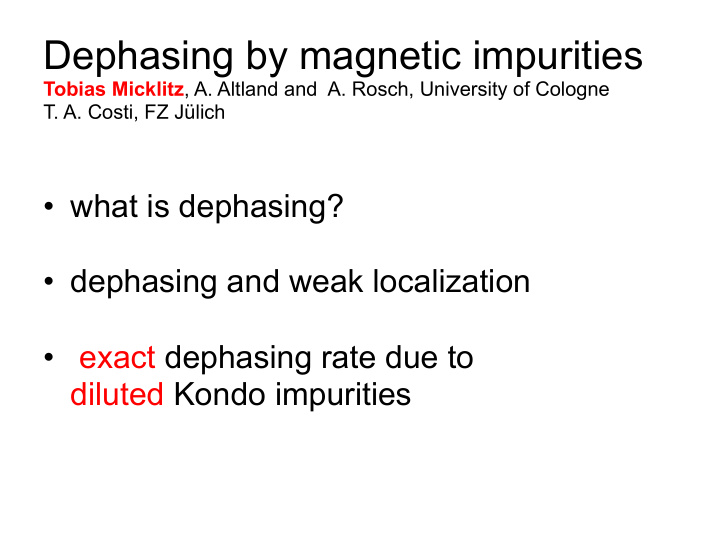



Dephasing by magnetic impurities Tobias Micklitz , A. Altland and A. Rosch, University of Cologne T. A. Costi, FZ Jülich • what is dephasing? • dephasing and weak localization • exact dephasing rate due to diluted Kondo impurities
� � What is dephasing? • depends on whom you ask and on precise experiment … • generally: loss of ability to show interference relevant for: mesoscopics, metal-insulator transition, quantum computing,… . • often: decay of off-diagonal elements of reduced � density matrix e.g. dephasing of Qbit by coupling to bath, non-equilibrium experiment finite dephasing rate even at • here: use weak localization as interference experiment close to equilibrium, expect: no dephasing at
Weak localization in weakly disordered metal Interference: classical quantum random potential random phases only constructive interference of time-reversed pathes weak localization (determined by return probabílity) interference correction to conductivity: loss of coherence after time due to dephasing
Origins of dephasing Pothie r • electron – phonon interactions • electron – electron interactions • interactions with dynamical impurities (magnetic impurities, two-level systems…)
� Measuring dephasing rates: idea: destroy interference of time-reversed pathes by magnetic flux measure change in resistivity Φ flux quantum enclosed after time
Saturation of dephasing rate at T=0? Mohanty, Jariwala, Webb (1996) Extrinsic origin of residual dephasing? heating, external noise etc. experimentally excluded Intrinsic origin ? Dephasing by zero-point fluctuations of EM field (Zaikin, Golubev); theoretically excluded (Aleiner, Altshuler, von Delft) Likely origin : magnetic (or other dynamic) impurities on ppm level but: only perturbative results known
Dephasing at T=0? extremely clean wires follow Altshuler, Aronov, Khmelnitzkii (82) prediction for e-e interactions typical sizes of wires: 50nm x 100nm x 300 µ m Pierre,Pothier et al. (03) Ag, Cu, Au wires 5N = 99.999% 6N = 99.9999%
model and diagrams • model: weakly disordered metal plus diluted spin-1/2 Kondo impurities • average over weak random nonmagnetic potential (Gaussian, large ) • average over positions of magnetic impurities, density • interactions only due to Kondo spins (no Coulomb)
Implanting magnetic Fe impurities Schopfer, Bäuerle et al. (03) Mohanty et al . 1996 15 ppm iron in gold approx. constant dephasing rate for approx. linear rate for goal: calculate exact dephasing rate no fit parameters if concentration and known
� � Is random for large ? randomness from short-range physics position of magnetic impurity in unit cell, clustering of impurities etc. may or may not be present randomness from long-range physics: from 1-loop RG
Result: fluctuations of can be neglected for (rare regions: exponentially small contribution to dephasing rate) diagrammatically: neglect mixed Kondo/disorder diagrams technically: suppressed as large however: can become important at low T (later) Disorder and interactions well separated
Weak localization and Kondo: self energy and vertices for self energy given by T-matrix: two types of vertices: include in first step only self-energies and elastic vertex corrections: neglect inelastic vertex later: exact for small density
solution of Bethe-Salpeter equation simple as inelastic vertex neglected: total cross-section elastic cross-section inelastic cross-section in Anderson impurity model with hybridization Δ
Corrections 1: from inelastic vertices • width of inelastic vertex: calculation gives inelastic vertices negligible for • vertex correction: time reversed electrons share same inelastic process relative phase: typical time: typical energy transfer:
Corrections 2: weak localization correction to dephasing rate always suppressed by large but wins at low T in d<2: only relevant in 1d for
Corrections 3: Altshuler Aronov • lowest T: non-local interaction effects get important (same universality class as disordered Fermi liquid) e.g. in 2d (up to logs) dominates below extremely low crossover-temperature All corrections negligible for experimentally relevant parameters!
Results: What is ? • both ε and T dependence of important define ε -independent with same WL correction • dependence on dimension and B accidentally small e.g. from Fermi liquid theory
Results: universal dephasing rate T-matrix calculated using numerical renormalization group (T. A. Costi)
comparison to experiment theory • Proper comparison to experiment: not yet done • to do: determine and independently • here: naïve fit works much too well (background!!) • role of spin S>1/2 and spin-orbit coupling? Schopfer, Bäuerle et al. (03) 15 ppm iron in gold
Interplay of electron-electron interactions and dephasing from Kondo impurities? • Does electron-electron interaction strongly affect Kondo-dephasing ? Probably not (small changes of energy averaging) • Does Kondo-dephasing strongly affect electron- electron interactions ? Yes: infrared divergencies dominate dephasing due to electron-electron interactions in 1d: • not additive do not subtract background, fit instead
Conclusions: • for diluted dynamical impurities: dephasing-rate determined by inelastic scattering cross-section • universal dephasing rate easily calculable Outlook: • � comparison to experiment: without fitting parameter • � Aharonov-Bohm oscillations (magn. fields), universal conductance fluctuations, persistent currents, …. • � ferromagnetic impurities, larger spins , fluctuating nano- domains, 2-channel Kondo: vertex corrections important T. Micklitz, A. Altland, T. A. Costi, A. Rosch, cond-mat/0509583
Recommend
More recommend